User111
On this page, you find all documents, package deals, and flashcards offered by seller user111.
- 8
- 0
- 0
Community
- Followers
- Following
8 items
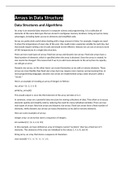
Introduction to Arrays in Programming
The document discusses the basics of arrays - a collection of data types stored in continuous memory locations. It highlights the need for arrays and the different types of arrays - fixed size and dynamic size - and their characteristics. The document also briefly touches upon how to use arrays. Examples are provided to illustrate the concepts discussed.
- Class notes
- • 2 pages •
The document discusses the basics of arrays - a collection of data types stored in continuous memory locations. It highlights the need for arrays and the different types of arrays - fixed size and dynamic size - and their characteristics. The document also briefly touches upon how to use arrays. Examples are provided to illustrate the concepts discussed.
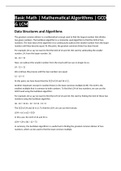
Introduction to the Euclidean Algorithm and Greatest Common Divisor (GCD) in Number Theory.
This document explains the concept of greatest common divisor (GCD) and the Euclidean algorithm, which is a commonly used algorithm to find the GCD of two numbers. It also discusses the importance of the least common multiple (LCM) and how the GCD can be used to find the LCM using a formula. The document provides an example of how to use the Euclidean algorithm to find the GCD of 24 and 36 and then how to use the GCD to find the LCM of these two numbers.
- Summary
- • 2 pages •
This document explains the concept of greatest common divisor (GCD) and the Euclidean algorithm, which is a commonly used algorithm to find the GCD of two numbers. It also discusses the importance of the least common multiple (LCM) and how the GCD can be used to find the LCM using a formula. The document provides an example of how to use the Euclidean algorithm to find the GCD of 24 and 36 and then how to use the GCD to find the LCM of these two numbers.

Learning Factorials and Trailing Zeros in Programming
This document discusses the concept of factorials and how to find the number of trailing zeros in them. It explains how twos and fives as a pair in a number result in the number of trailing zeros, and provides the formula n/5 + n/25 + n/125 + ... to find the number of fives in a factorial. The document also explains how to stop the process of finding the number of fives by adding 1 to all the numbers on the blackboard. Overall, this document emphasizes the importance of understanding factorials ...
- Summary
- • 1 pages •
This document discusses the concept of factorials and how to find the number of trailing zeros in them. It explains how twos and fives as a pair in a number result in the number of trailing zeros, and provides the formula n/5 + n/25 + n/125 + ... to find the number of fives in a factorial. The document also explains how to stop the process of finding the number of fives by adding 1 to all the numbers on the blackboard. Overall, this document emphasizes the importance of understanding factorials ...

Understanding Prime Numbers and How to Check for Primality in Python
The document is a brief discussion about prime numbers and how to determine whether a given number is prime or not. It defines what prime numbers are, and provides a simple algorithm for testing whether a number is prime. The algorithm involves checking if the number is less than 2, equal to 2, or even. If it passes those tests, the algorithm then loops through all odd numbers less than or equal to the square root of the given number and checks for divisors. If the number is divisible by any of ...
- Summary
- • 2 pages •
The document is a brief discussion about prime numbers and how to determine whether a given number is prime or not. It defines what prime numbers are, and provides a simple algorithm for testing whether a number is prime. The algorithm involves checking if the number is less than 2, equal to 2, or even. If it passes those tests, the algorithm then loops through all odd numbers less than or equal to the square root of the given number and checks for divisors. If the number is divisible by any of ...

Data Structures And Algorithms Basic Math: Finding the Reverse of a Number using Divide and Percent Sign
This document provides a brief explanation of two mathematical concepts: divide and percent sign, followed by an example of how to find the reverse of a number using these concepts. The author demonstrates step-by-step how to find the reverse of a number and provides an example to clarify the concept. The document then goes on to discuss a question involving the reverse of a number, and the author provides a solution to the problem. Overall, this document is a useful resource for anyone who want...
- Summary
- • 2 pages •
This document provides a brief explanation of two mathematical concepts: divide and percent sign, followed by an example of how to find the reverse of a number using these concepts. The author demonstrates step-by-step how to find the reverse of a number and provides an example to clarify the concept. The document then goes on to discuss a question involving the reverse of a number, and the author provides a solution to the problem. Overall, this document is a useful resource for anyone who want...
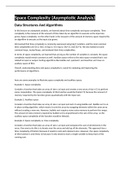
Understanding Time and Space Complexity in Algorithms: Examples and Explanation
This document provides an overview of the concept of time complexity and space complexity in computer science. It explains how time complexity is measured as the amount of time taken by an algorithm to execute as the input size grows, and how space complexity is measured as the amount of memory space required by an algorithm to execute as the input size grows. The document also covers the commonly used big O notation and the most common time complexities. Additionally, it discusses the concept o...
- Summary
- • 2 pages •
This document provides an overview of the concept of time complexity and space complexity in computer science. It explains how time complexity is measured as the amount of time taken by an algorithm to execute as the input size grows, and how space complexity is measured as the amount of memory space required by an algorithm to execute as the input size grows. The document also covers the commonly used big O notation and the most common time complexities. Additionally, it discusses the concept o...
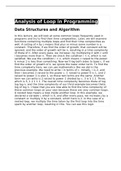
Analyzing Time Complexity of Loops in Programming: Understanding Common Loop Structures and Nested Loops
This document provides an in-depth understanding of time complexity and how it relates to loops in programming. The document explores common loops used in programs and provides examples of how to calculate their time complexity. It also covers nested loops and how to calculate their time complexity by multiplying the time taken by each loop. The document uses mathematical concepts to explain the time complexity of loops and provides practical examples to help readers understand the concept. This...
- Summary
- • 1 pages •
This document provides an in-depth understanding of time complexity and how it relates to loops in programming. The document explores common loops used in programs and provides examples of how to calculate their time complexity. It also covers nested loops and how to calculate their time complexity by multiplying the time taken by each loop. The document uses mathematical concepts to explain the time complexity of loops and provides practical examples to help readers understand the concept. This...
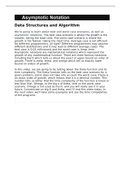
Summary Data Structures (Asymptotic Notation)
This document provides an introduction to the concept of best and worst case scenarios, as well as asymptotic notations, which are mathematical notations used to represent the growth of any mathematical function. The document explains the different types of notations, including big O and theta, and how they can be used to determine the time complexity of a given function. The document also highlights the importance of understanding these notations for programmers and provides a preview of future...
- Summary
- • 1 pages •
This document provides an introduction to the concept of best and worst case scenarios, as well as asymptotic notations, which are mathematical notations used to represent the growth of any mathematical function. The document explains the different types of notations, including big O and theta, and how they can be used to determine the time complexity of a given function. The document also highlights the importance of understanding these notations for programmers and provides a preview of future...
